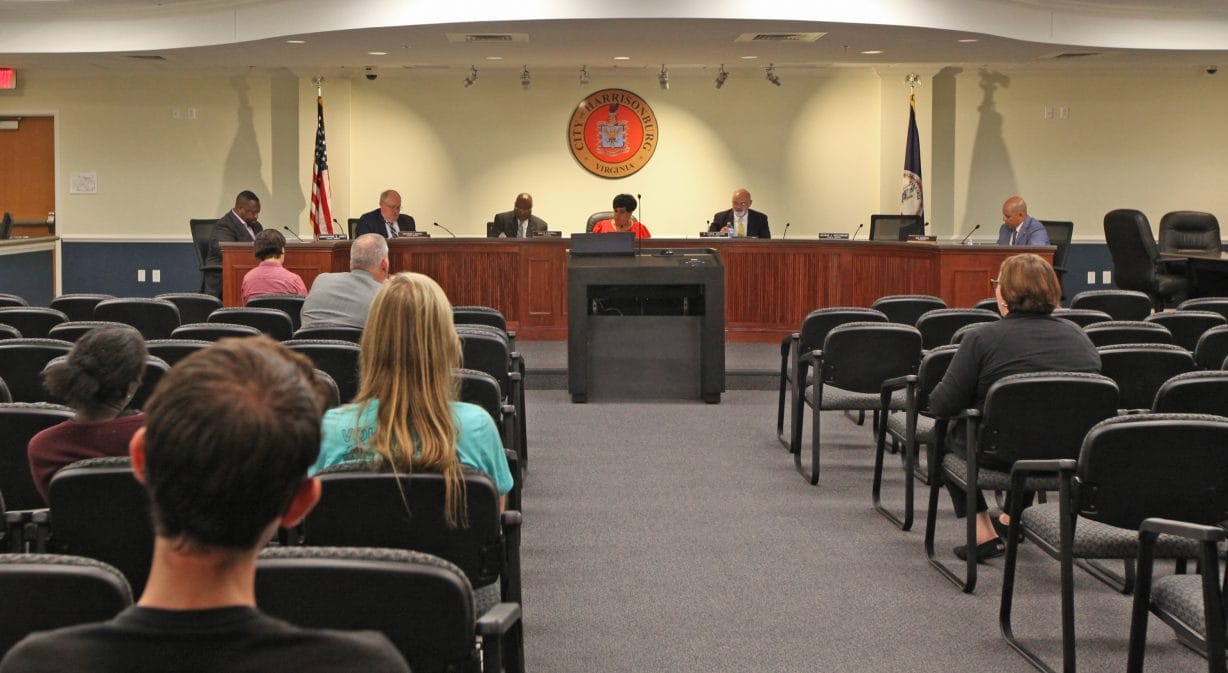
By Randi B. Hagi, assistant editor
Harrisonburg could soon see cable and internet providers employ a new way of hooking up fiber optic lines to homes using a process called “microtrenching,” Tom Hartman, director of public works, told the City Council at Tuesday’s meeting.
Microtrenching, Hartman explained, is a “new technology” associated with fiber optic cables that allows those cables to be laid in one-and-a-half inch wide, 14 inch deep trenches for along residential streets.
A public access permit, which already exists, is required for any contractor or private citizen doing work in the city’s right-of-way, such as installing or maintaining gas lines or building entrances. The updates Hartman presented on Tuesday include regulations pertaining to microtrenching and small-cell wireless facilities.
Also new is a $100 application fee for each permit, with additional fees “based on the type of work that they’re performing,” Hartman said.
He said the fees will cover staff time to review and approve applications and inspect work in the field.
The new permitting system will go into effect on Nov. 4. Hartman said companies interested in using microtrenching in the city could begin as early as November or December.
Shentel, a company based in Edinburg, Va., already has been installing fiber optic cable lines in parts of the city after expanding its telecommunications services in the city.
Storm water option
A Public Works project to address neighborhood stormwater issues earned unanimous approval from the council, establishing the Drainage Improvements Program Policy. Council member George Hirschmann was absent from the meeting.
This policy allows for neighborhood groups, such as residents along the same street, or neighbors or businesses with adjacent properties, to formally request the city study and fund drainage improvements.
“This all started last May … when all of a sudden, the skies opened up,” Hartman said. City staff received 97 service requests for drainage issues last year, but 70 percent of the requests were for privately owned property – which the city had limited ability to address.
Hartman explained that this program is aimed at “larger scale problems,” as opposed to the Harrisonburg Conservation Assistance Program, which launched this summer to help individual property owners mitigate stormwater runoff.
Projects could include closed drainage systems, curb and gutter renovations and stormwater bioretention areas.
The approval process for the Drainage Improvements Program applicants will likely be arduous. Hartman said he anticipates a 5-to-10 percent acceptance rate, as projects will need to demonstrably improve a large area, should include multiple property owners who participate in the process and be feasible for the city to execute.
And once an application gets through city staff, the Stormwater Advisory Committee and an engineering study, it will still need city council approval for funding.
The approval process “requires citizens to come together as a community,” Hartman said.
Hartman said the application process is based on similar programs in Minnesota, Washington and Washington, D.C.
“I think it absolutely addresses something that … slips through the cracks,” council member Richard Baugh said. He also serves on the Stormwater Advisory Committee.
“We may be one of the few jurisdictions in Virginia that’s making this effort.”
Also at the meeting:
- The council unanimously approved spending $153,000 to buy three-quarters of an acre adjacent to the site slated for the construction of the new high school, which will be located between South Main Street and I-81.
City Attorney Chris Brown said the parcel was necessary to “allow good access to the northern side of the campus” from South Main Street. - The council unanimously authorized the Shenandoah Valley Regional Airport to take on debt in order to construct larger aircraft hangars and replace 30-year-old bulk fuel storage tanks. Harrisonburg is not liable for the debt, but is one of the five jurisdictions that make up the Shenandoah Valley Airport Commission and must give their approval for such financial transactions.
- The council unanimously voted to rename a portion of Hillcrest Drive, between Port Republic Road and East Weaver Avenue, to Carrera Lane. The change ensures that the one property fronting that section of the road will not have a similar address to those on the other Hillcrest Drive, in the Park View neighborhood near EMU, which could pose a problem for emergency responders.
- Council member Chris Jones recognized Keung Khochareun, the founder of the Taste of Thai restaurant and Oriental Food Market, who died Sept. 18. Jones said Khochareun fled his home country of Laos to Thailand, and “eventually brought that great mind and success to Harrisonburg.”
Journalism is changing, and that’s why The Citizen is here. We’re independent. We’re local. We pay our contributors, and the money you give goes directly to the reporting. No overhead. No printing costs. Just facts, stories and context. Thanks for your support.














